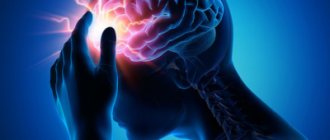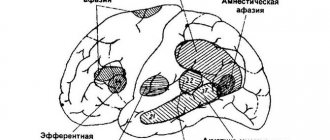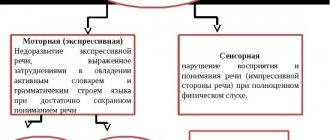Peculiarities
Motor aphasia is brain damage in Broca's area, which is characterized by irreversible organic changes in brain tissue with a complete loss of its functional activity in this area. Experts distinguish two main clinically significant forms of motor aphasia: afferent and efferent motor aphasia. With this disease, there is a disruption of the synthetic activity of the brain with loss of speech function, together with its perception. In this case, the patient has no situational speech, i.e. the patient cannot maintain a dialogue because he simply does not perceive it.
Afferent motor aphasia
Afferent or kinesthetic aphasia is manifested by difficulty in reproducing speech, mainly due to problems in the articulatory apparatus. Thus, patients with afferent motor aphasia cannot and cannot connect their own speech into a complete structured sentence.
Patients often try to replace words that they cannot pronounce with synonyms, which leads to a significant slowdown in spoken speech. The difficulty in pronouncing consonant sounds also attracts attention.
In most cases, afferent motor aphasia is combined with agraphia, a writing disorder.
Efferent motor aphasia
It occurs as a result of damage to the premotor areas of the cerebral cortex. Efferent motor aphasia manifests itself by literally jamming the patient’s speech on specific sounds. The patient cannot change the position of the articulatory apparatus, which leads to large time pauses between pronounced sounds. Speech becomes telegraphic or stamped.
It is worth noting that in almost half of all cases of identified motor aphasia in patients, a combination of both afferent and efferent aphasia occurs. Mixed aphasia is manifested by a complex manifestation of all of the above manifestations, which is called the term sensorimotor speech disorder.
SENSORY APHASIA
Stage of severe disorders
1. Accumulation of everyday passive vocabulary:
— display of pictures depicting objects and actions by their names, functional, classification and other characteristics
— display of pictures depicting objects belonging to certain categories (“clothing”, “dishes”, “furniture”, etc.);
- showing body parts in the picture and in yourself;
- choosing the correct name of the object and action among the correct and conflicting designations based on the picture.
2. Stimulation of understanding of situational phrasal speech:
- answering questions with words “yes”, “no”, affirmative or negative gesture;>
- following simple oral instructions;
— capturing semantic distortions in simple phrases deformed in meaning.
3. Preparation for restoration of written speech:
— laying out captions for subject and simple plot pictures;
— answers to questions in a simple dialogue based on visual perception of the text of the question and answer;
- writing words, syllables and letters from memory;
- “voiced reading” of individual letters, syllables and words (the patient reads “to himself”, and the teacher reads out loud);
- development of the “phoneme-grapheme” connection by selecting a given letter and syllable by name, writing letters and syllables under dictation.
Moderate stage of disorders
1. Restoration of phonemic hearing:
- differentiation of words that differ in length and rhythmic structure;
- highlighting the same 1st sound in words of different lengths and rhythmic structures, for example: “house”, “sofa”, etc.;
- highlighting different 1st sounds in words with the same rhythmic structure, for example, “work”, “care”, “gate”, etc.;
- differentiation of words that are similar in length and rhythmic structure with disjunctive and oppositional phonemes by identifying differentiated phonemes, filling in gaps in words and phrases; capturing semantic distortions in a phrase; answers to questions containing words with oppositional phonemes; reading texts with these words.
2. Restoring understanding of the meaning of a word:
— development of generalized concepts by classifying words into categories; selection of a generalizing word for groups of words belonging to one or another category;
— filling in gaps in phrases;
- selection of definitions for words.
3. Overcoming oral speech disorders:
— “imposing a framework” on a statement by composing sentences from a given number of words (instructions: “Make a sentence of 3 words!”, etc.);
— clarification of the lexical and phonetic composition of the phrase using the analysis of verbal and literal paraphasias admitted by the patient;
— elimination of elements of agrammatism using exercises to “revitalize” the sense of language, as well as analysis of grammatical distortions.
4. Restoration of written speech:
- strengthening the “phoneme-grapheme” connection by reading and writing letters under dictation;
— various types of sound-letter analysis of the composition of a word with a gradual “collapse” of external supports;
- writing from dictation of words and simple phrases;
- reading words and phrases, as well as simple texts, followed by answers to questions;
- independent writing of words and phrases from pictures or written dialogue.
Stage of mild disorders
1. Restoring understanding of extended speech:
— answers to questions in an expanded, non-situational dialogue;
- listening to texts and answering questions about them;
— capturing distortions in deformed compound and complex sentences;
— understanding of logical and grammatical figures of speech;
— implementation of oral instructions in the form of logical and grammatical figures of speech.
2. Further work to restore the semantic structure of the word:
- selection of synonyms as homogeneous members of a sentence and out of context;
- work on homonyms, antonyms, phraseological units.
3. Correction of oral speech:
— restoration of the self-control function by fixing the patient’s attention on his mistakes;
- compiling stories based on a series of plot pictures;
- retelling texts according to plan and without plan;
— drawing up plans for texts;
- composing speech improvisations on a given topic;
— speech sketches with elements of “role-playing games”.
4. Further restoration of reading and writing:
— reading expanded texts, various fonts;
- dictations;
- written statements;
- written essays;
- mastering samples of congratulatory letters, business notes, etc.
Causes of afferent motor aphasia
The causes of the formation of motor afferent aphasia are a number of diseases that lead to organic damage to the cerebral cortex, including Broca’s area, as well as the premotor cortex. Most often, afferent aphasia is caused by diseases with extensive damage to brain structures, for example:
- Acute cerebrovascular accident or stroke. Moreover, a stroke is hemorrhagic in nature, in which massive hemorrhage occurs in the structures of the brain. Blood soaking and compression of the posterior regions of the frontal zone leads to damage to Broca's center and the development of afferent motor aphasia;
- Infectious and inflammatory diseases of the brain. Most often these include encephalitis or leukoencephalitis. Inflammatory diseases lead to softening of brain tissue and the formation of abscess cavities;
- Traumatic brain injuries, especially with severe brain contusion and subarachnoid hemorrhage. Brain contusion and edema lead to compression of brain structures, which can also damage Broca’s center;
- Development of a tumor process localized in the frontal or temporal lobes on the side of the dominant hemisphere;
- Epilepsy, in the presence of an epileptogenic focus in close anatomical proximity to the speech center of the brain;
- Toxic damage to brain structures, for example, from heavy metals or other poisons.
A number of chronic diseases also contribute to the development of afferent motor aphasia:
- Chronic pathology of blood circulation, due to the presence of an aneurysm or atherosclerotic changes in the vascular wall of the cerebral arteries.
- Slowly progressive diseases of the central nervous system: multiple sclerosis or encephalomyelitis. Demyelination of nerve fibers leads to disruption of afferent and efferent connections of the speech center with other structures of the brain;
- Formation of prion protein.
SEMANTIC APHASIA
Stage of disorders of moderate and mild severity
1. Overcoming spatial apractognosia:
— a schematic representation of the spatial relationships of objects;
- image of the plan of the path, room, etc.;
- design according to a model, according to a verbal task;
— work with a geographical map, hours.
2. Restoring the ability to understand words with spatial meaning (prepositions, adverbs, verbs with “movement” prefixes, etc.):
— a visual representation of simple spatial situations denoted by prepositions and other parts of speech;
— filling in missing “spatial” elements in words and phrases;
- composing phrases with words that have spatial
3. Construction of complex sentences:
— clarification of the meanings of subordinating conjunctions;
— filling in missing main and subordinate clauses;
- composing sentences with given conjunctions.
4. Restoring the ability to understand logical and grammatical situations:
- a picture depiction of the plot of the structure;
- the introduction of additional words that provide semantic redundancy (“my brother’s father”, “a letter from a beloved friend”, etc.);
— introduction of logical-grammatical constructions into a detailed semantic context;
- presenting designs in writing and then orally.
5. Work on an extended statement:
- presentations, essays;
— improvisation on a given topic;
- interpretation of words with complex semantic structure...
Article from the site: wapref.ru/referat_qasyfsujgpolyfsaty.html
Symptoms
Afferent aphasia is accompanied by the occurrence of a number of symptoms and syndromes, which form the clinical picture characteristic of this form. Expressive language impairment syndrome includes:
- Violation of spatial movements, such as facial expressions and gestures, as well as a complete absence of situational speech process. When trying to repeat sounds, the patient makes only isolated movements with his lips and tongue;
- Speech becomes overly clichéd, there are syllable and sound dropouts.
The patient also experiences pronounced difficulties in pronouncing complex syllables, namely: they divide words into parts and skip the most complex sounds. There is a violation of the understanding of someone else's speech, however, this period does not last long from a day to several days and occurs after suffering an acute cerebrovascular accident.
The victim’s spatial disorientation, as well as impairment of writing and perception of visual text information, are also noteworthy. When writing, the patient shifts vowels, omits consonants, and changes the order of letters.
ACOUSTIC-MNESTIC APHASIA
Stage of disorders of moderate and mild severity
1. Expanding the scope of auditory perception:
— display of objects (real and in pictures) by name, presented in pairs, triplets, etc.;
- showing body parts according to the same principle;
— implementation of 2-3-level oral instructions;
— answers to detailed questions, complicated by syntactic structure;
- listening to texts consisting of several sentences and answering questions about the content of the texts;
- writing from dictation with a gradual increase in phrases;
- reading gradually increasing phrases, followed by reproduction (from memory) of each of the sentences and the entire set as a whole.
2. Overcoming weakness of auditory-speech traces:
- repetition from memory of read letters, words, phrases with a gradual increase in the time interval between reading and reproduction, as well as filling the pause with some other type of activity;
— memorizing short poems and prose texts;
— repeated display of objects and pictures after 5-10 seconds, after 1 minute. after the first presentation;
- reading texts with time-delayed retelling (after 10 minutes, 30 minutes, the next day, etc.);
- composing orally sentences using reference words perceived visually;
- listing words by letter with a gradually more complex sound structure, and gradually moving away from the written example of these words.
3. Overcoming naming difficulties:
- analysis of visual images and independent drawing of objects denoted by name words;
- semantic play in contexts of various types of words denoting objects, actions and attributes of objects;
— classification of words with independent finding of a generalizing word;
— exercises on the interpretation of words with concrete, abstract and figurative meaning.
4. Organization of a detailed statement:
- compiling a story based on a series of plot pictures;
- retelling of texts, first according to a detailed plan, then according to a condensed plan, then without a plan;
- extensive dialogues on non-situational topics (professional, social, etc.); practicing samples of communicative and narrative writing (greeting cards, letters, statements, essays on a given topic, etc.).
Diagnostics
The diagnostic search is aimed at identifying the underlying disease or cause that served as the impetus for the development of motor afferent aphasia. The diagnostic plan includes a standard set of studies. The first step is to collect an anamnesis of the disease, after which a topical diagnosis is carried out to determine the expected extent of damage to brain tissue, then a preliminary diagnosis is made.
To clarify it, a number of instrumental studies are carried out, such as:
- Magnetic resonance imaging of the brain, and contrast can also be used to improve brain imaging characteristics. Magnetic resonance imaging allows you to identify oncological lesions, the presence and volume of a hematoma in traumatic brain injury;
- Angiography of cerebral arteries for the presence or absence of vascular pathology;
- Ultrasound Doppler examination of neck vessels;
- Lumbar puncture if there is suspicion of encephalitis, meningitis or leukoencephalitis;
- Electroencephalography to exclude pathology of an epileptiform nature or oncological lesions of the brain.
The Clinical Brain Institute is focused on studying, diagnosing and treating patients with neurological symptoms, including patients with motor aphasia. The Clinical Institute of the Brain operates a powerful and modern diagnostic department, which makes it possible to make correct diagnoses with a high degree of probability.
Treatment
The main treatment should be aimed at eliminating the underlying cause that led to the formation of afferent motor aphasia. Depending on the underlying pathology, treatment tactics will differ significantly.
- In the presence of a tumor process, surgical intervention on the brain or a course of radiation and chemotherapy.
- In the presence of an infectious focus or abscess, drainage in combination with antibacterial therapy and the use of general stabilizing drugs.
- In case of acute cerebrovascular accident - a course of treatment with drugs with nootropic effects, antioxidants, angioprotectors. For hemorrhagic stroke with severe compression of the brain - surgical treatment.
- For epilepsy, the main therapy is aimed at the use of anticonvulsants.
- For demyelinating and degenerative processes in nervous tissue, glucocorticosteroids are used.
All of the above treatment regimens will be effective in the treatment of aphasia, as they have a pathogenetic mechanism for correcting the pathological manifestations of the disease.
Rehabilitation
It is very important that the treatment is comprehensive and closely related to rehabilitation measures. The Clinical Institute of the Brain is one of the first centers in the country that began the combined use of therapeutic and rehabilitation measures. Rehabilitation consists of:
- Systematic visits to a speech therapist, at least three times a week;
- Dual mode operation, i.e. both with a specialist and independently.
Rehabilitation classes are aimed at restoring articulate speech; for this, patients sing songs and read poetry, since during these classes words are stretched into syllables and train the patient’s articulatory apparatus. Separately, it is worth mentioning the restoration of writing; for this, patients write letters under dictation.
For a more effective and quick recovery of the patient, it is necessary to involve close relatives and friends in treatment. The patient should not be allowed to remain and be in social isolation for a long time.
At the Clinical Institute of the Brain, there is a specialist aphysiologist who develops individual programs for each individual patient to restore speech and writing function in cases of severe cognitive disorders.
Adviсe
Aphasia is not a mental illness, even if there are severe speech impairments. It is worth treating the patient with understanding and patience. You should not raise your voice at the patient, as this will not improve the understanding of the information and the meaning of what is being said. You should speak to the patient as slowly as possible, without using complex structures in sentences. Gestures should also be limited. Use questions that can be answered with a clear yes or no.
To improve the perception of information by patients, try to exclude all extraneous noise. Try not to limit the patient’s communication and ask him more questions.
DYNAMIC APHASAIA
Stage of severe disorders
1. Increasing the level of general activity of the patient, overcoming speech inactivity, organizing voluntary attention:
- performing various types of non-verbal activities (drawing, modeling, etc.);
— assessment of distorted images, words, phrases, etc.;
- situational, emotionally significant dialogue for the patient;
- listening to plot texts and answering questions about them in the form of affirmative-negative gestures or words “yes”, “no”.
2. Stimulating simple types of communicative speech:
— automation in dialogical speech of communicatively significant words: “yes”, “no”, “can”, “want”, “will”, “must”, etc.;
— automation of individual cliches of communicative, incentive and interrogative speech: “give”, “come here”, “who’s there?”, “hush!” etc.
3. Overcoming speech programming disorders:
- stimulation of answers to questions with a gradual decrease in the answer of words borrowed from the question;
- constructing phrases of the simplest syntactic models based on chips and a simple plot picture;
- performing simple grammatical transformations to change words that make up a phrase, but are presented in nominative forms;
- laying out a series of sequential pictures according to the plot contained in them.
4. Overcoming grammatical structuring disorders
5. Stimulating written speech:
— laying out captions under pictures;
- reading ideogram words and phrases.
Moderate stage of disorders
1. Restoration of communicative phrasal speech:
— construction of a simple phrase;
- composing phrases based on a plot picture using the chip method and gradually “collapsing” the number of external supports;
- compiling a story based on a series of sequential pictures;
— detailed answers to questions in the dialogue;
- compiling simple dialogues like speech sketches: “In a store” - a dialogue between a buyer and a seller, “In a savings bank”, “In an atelier”, etc.
2. Overcoming perseverations in independent oral and written statements:
- display of objects in pictures and in the room, parts of the body (in random order, by individual names and by series of names);
- ending phrases with different words;
- selection of words of given categories and in given quantities, for example, two words related to the topic “Clothing” and one word related to the topic “Tableware”, etc.;
- writing numbers and letters broken down (from dictation);
- writing from dictation of words and phrases that contribute to the development of semantic and motor switching;
— elements of sound-letter analysis of the composition of a word: folding simple words from letters of a split alphabet;
- filling in gaps in words;
- writing simple words from memory and dictation.
Stage of mild disorders
1. Restoration of spontaneous communicative phrasal speech:
- extensive dialogue on various topics;
- constructing phrases based on a plot picture with a gradual decrease in the number of external supports;
— automation of phrases of certain syntactic models in spontaneous speech;
- accumulation of a verbal dictionary and “revitalization” of the semantic connections behind the predicate (with the help of questions posed to it);
- reading and retelling texts;
- “role-playing conversations”, playing out a certain situation;
- “speech improvisations” on a given topic;
- detailed presentations of texts, essays;
- drafting greeting cards, letters, etc.
Prevention of afferent and efferent motor aphasia
There is no specific prevention for the development of aphasia. All preventive measures are primarily aimed at eliminating risk factors that increase the risk of vascular diseases. Since acute cerebrovascular accident is the most common cause of aphasia, stroke prevention has an indirect effect on the development of aphasia.
Timely treatment of arterial hypertension, correction of the blood lipid profile, as well as annual preventive examinations will help to avoid extensive brain damage.
As with any other disease, prevention implies:
- Maintaining a healthy lifestyle;
- Proper nutrition;
- Normalization of the work-rest regime;
- Rejection of bad habits.
What is developmental dysphasia?
Dysphasia is understood as persistent underdevelopment or complete absence of speech in a child. This pathology is associated with certain organic lesions in the cerebral cortex, which is responsible for the development of speech skills. Dysphasia is often confused with aphasia, in which the child stops speaking due to loss of speech skills. This happens as a result of severe injuries resulting in concussion, vascular diseases or surgery on the cerebral cortex, as well as its tumors.
Dysphasia always begins to manifest itself in the perinatal or early period of development of the infant's speech skills. The severity of the disease when visiting a doctor is determined based on the time of damage to the brain systems. The most dangerous periods are considered to be 3–4 months of pregnancy. A child with this disease not only cannot speak, but also often poorly understands the speech of the people around him.
REFERENCE! Dysphasia in the Russian classification of diseases is called alalia. This term should not be confused with the common disease dyslalia, in which the child has speech, but is severely distorted. Various sources also give the same type of name for dysphasia - this is “early childhood dysphasia” or “developmental dysphasia”.






